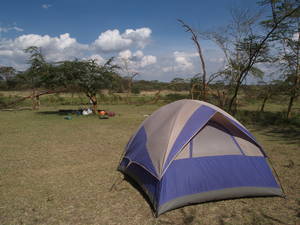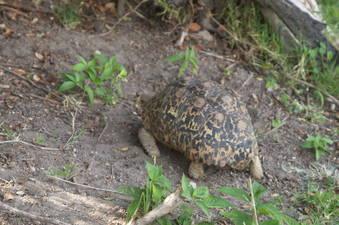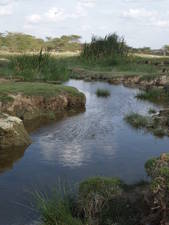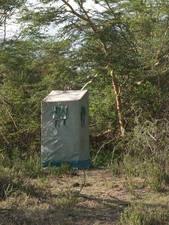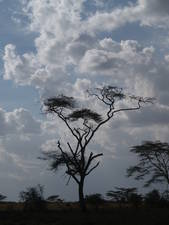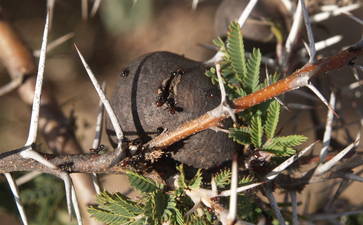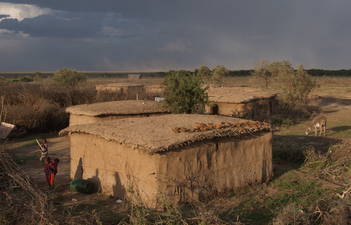Into Maasai country
Saturday 12th March
Our flight landed after 9.30pm and by the time we got through immigration
(paying for our visas) and collected our luggage it was quite late.
We were met by an IntoAfrica driver and whisked straight to the Rock
House hotel in Nairobi's western suburbs. So all we saw of the city were
advertising billboards and the light industrial area near the airport,
and something of the main roads passing south of the centre.
By the time we showered and did some repacking it was 12.30am.
Our flight gave us good views of the Alps as we passed west
of Innsbruck, then came down the Adriatic and right over the Quattara
Depression. I'm not sure if the route would normally have overflown
Libya, but we certainly didn't!
I read Alan Furst's
The Spies of Warsaw on the plane.
Sunday 13th March
After breakfast we met our guide (Kassim), driver (Duncan) and cook
(Demetrios) and were soon under way. As we drove through Karen (the
suburb which may or may not be named after Karen Blixen) we noted the
high density of schools and churches, and the people dressed in
their Sunday best. (I have no photographs, as the general
rule in East Africa is not to photograph people without permission.)
We stopped for petrol and money from an ATM, and a woman told Duncan
off for taking the wrong exit from the service station. He told us she
was a "mzungu" (which I think means "foreigner" but was being used as
a derogatory word for white settler).
A baboon crossing the road was our first hint at the wildlife. And our
first stop was at a viewpoint on the descent into the Rift Valley,
where there were other tourists — and salesmen trying to sell us
all souvenirs.
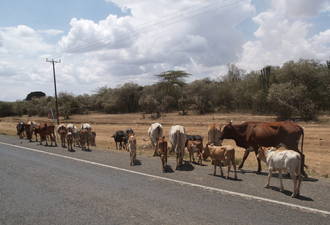
Maasai cattle
Crossing the Rift Valley we passed scattered homesteads and some
settlements, but it was mostly dry grassland. There were
Maasai herding cattle and sheep and we
saw our first gazelle, Thompsons and Grants, and ostrich here. We stopped
in Narok for a packed lunch (all the food on the trip was prepared by
Demetrios, which alleviated worries about hygiene and was presumably
also cheaper).
Soon after Narok we left the main road and continued on gradually less
substantial roads, eventually arriving at a campsite in what felt like
the middle of nowhere. This was a grassy patch on the edge of a small
yellow-butt acacia forest (apparently much reduced by elephants), just
above a watercourse.
Duncan and Demetrios drove to a nearby village to collect our toilet,
tents, dining table and cooking gear. While they were setting up the
camp we saw a leopard tortoise, which seemed most ungainly as it pushed
up a slight slope under a branch into the bushes. And the watercourse
had birds, including a greyheaded kingfisher, black-winged stilt, and
saddle-billed storks.
Kassim explained "the
small five": the leopard tortoise, antlion, rhinoceros beetle,
buffalo weaver bird and elephant shrew. (I wonder if anyone runs
wildlife tours looking for insects and small mammals.)
We walked to the Maasai village, past where a new one was being built
(the current village, with 62 people in three familes, was getting too big
and was going to be split into three, so these are really homesteads
rather than villages). There was a multi-day naming ceremony for a
two year old happening, and when we visited one of the houses I drank
a little of the huge quantity of beer(?) they had brewed for the occasion.
The village we visited was quite remote and showed few signs of the
modern world — apart from mobile phones! — but it didn't
feel indigent and wasn't confronting in the way (say) rural India is.
Tourists obviously came regularly and no one made a big fuss over us,
but there wasn't any attempt to sell us anything or any request for
donations, either. This was a different world working by its own
rules, and there was none of the unpleasantness that comes when disparate
worlds are forced together, such as the begging or desperate attempts
to sell souvenirs we encountered in a few places. (I didn't go away feeling
poor because I don't own any cows.)
IntoAfrica was presumably paying the village — for storage of
the tent, toilet, etc. and for us to take photos — as well as
providing employment — guards at night and a guide
the following morning.
There was a brief rainstorm while we were walking back to our camp,
with huge raindrops competing with a hot, dry wind.
Dinner was excellent fried Nile perch fillet with vegetables and potatos.
Four Maasai warriors guarded our campsite during the night, literally
sleeping just outside each tent. But I slept so soundly I missed
this, and the trumpeting elephants.
Next: Loita plains, Maji Moto, Siana conservation area
Up: Kenya + Tanzania


